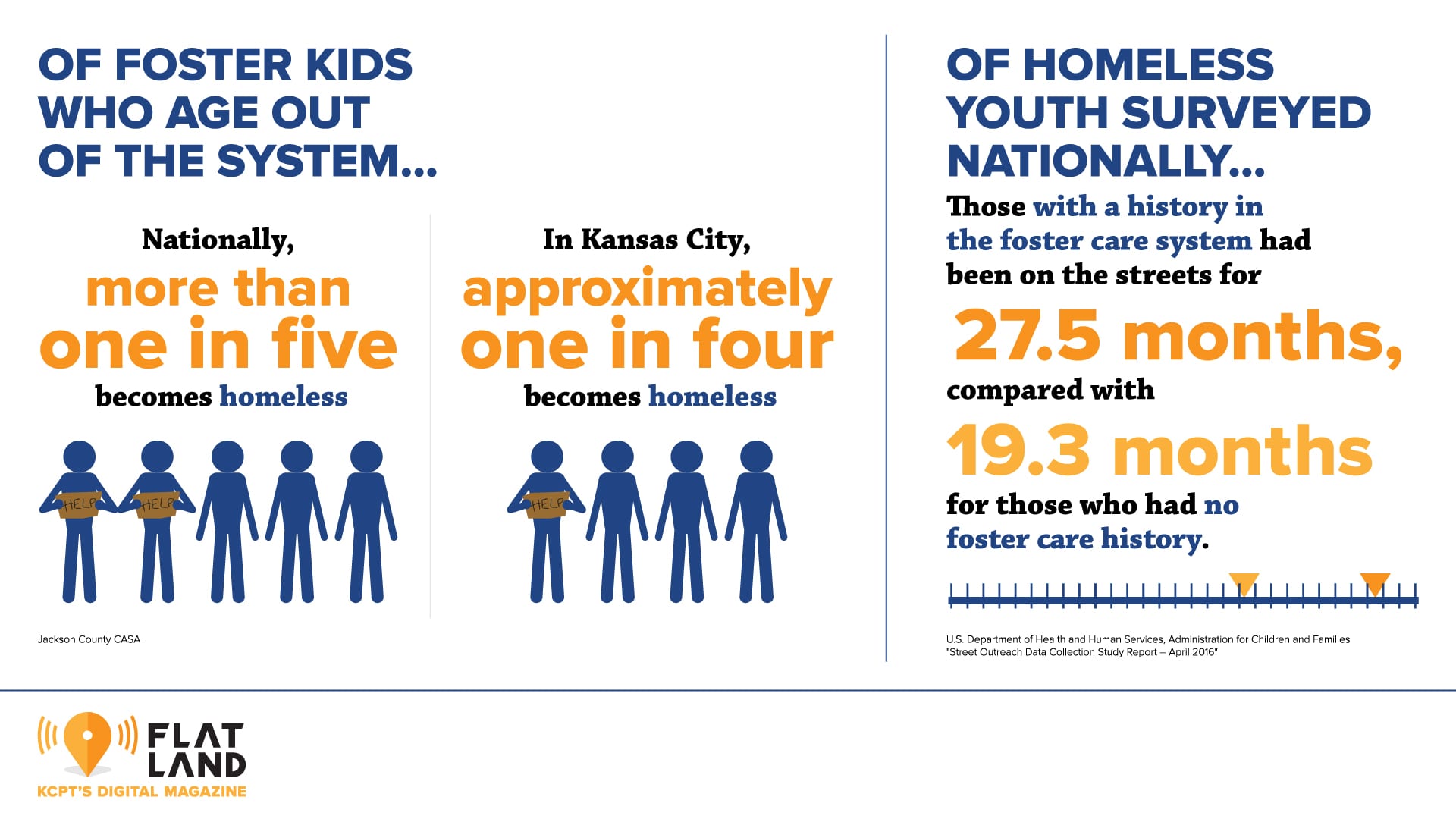From the Frying Pan of Foster Care to the Fire of Adulthood Shelters, Nonprofits Fill Some Gaps in Care
Published July 2nd, 2018 at 6:00 AM
Above image credit: The Waldo apartment complex that is part of a transitional living program avoids an institutional feel by having bright colors and corridors that get plenty of sunshine. (Mike Sherry | Flatland)Finally becoming old enough to drink legally is often accompanied by a night out on the town, but the experience can be quite different for foster kids in Missouri.
“We’ve heard stories of kids who were dropped off at City Union Mission by their social worker because it’s the kid’s 21st birthday,” said Nathan Ross, youth programs supervisor at the nonprofit social service agency FosterAdopt Connect. “Here’s your bag, here’s your stuff. I can’t work with you anymore because you’re over age.”
Is it any surprise then that, according to federal data, upwards of one-third of the young adults aging out of the foster system each year in the Kansas City metropolitan area end up homeless by the age of 21?
A 2017 report from Child Trends surveyed independent living coordinators from across the country regarding aging-out youth and services states provide. Housing, they said, was the area most in need of improvement.
Only 9 percent of kids who had been in foster care had their own residence by age 26, whereas 30 percent of the general population did, according to the study. Forty-five percent of young adults from the system had experienced an economic hardship like not having enough money to pay rent, as opposed to 18 percent of their peers.
In the Kansas City area, nonprofit providers have formed a loose-knit safety net for youth who fall through the cracks of state-provided services.
Why the Need?
There are a lot of reasons why children aging out end up homeless.
For one, they have few, if any, social supports. When they lose a job or a lease, there is nowhere to turn for help. Before being removed, they were neglected in their homes, where there is often generational poverty, violence or addiction, making it difficult to break these cycles.
Then, they are put into a system that only adds trauma by moving them into new places where they know no one, said Angie Blumel, CEO of the Jackson County office of the National Court Appointed Special Advocate (CASA) Association. Kids who eventually age out can spend as many as three years shuffling between placements, which is longer than for children who get adopted.
“To say we are going to put them in the system and fix those long-term issues is incorrect,” Blumel said. “We are trying to add support and opportunities and connect them with services, but because of the trauma of abuse and neglect, plus the institutional trauma, there’s a lot working against these kids.”
And part of that is funding, said Brad Smith, executive director of the Drumm Farm Center for Children in Independence, Missouri.
“For a child in foster care, the state of Missouri supports them somewhere around $11 a day,” he said. “We are spending less on child welfare than at any time in the last 30 years. That we are having problems shouldn’t be shocking.”
Evie Craig, CEO of reStart Inc., a homeless services organization in Kansas City, described this group as suffering “developmental malnutrition” in a system that too often just warehouses its charges. A lot of young adults who age out have been living in congregate-care settings where they don’t do things like cook meals, do laundry or handle money.
And this has financial consequences for us all. The Annie E. Casey Foundation has estimated that kids aging out of foster care cost society $8 billion more each year than their counterparts in the general population.
Kansas and Missouri do provide some supports to these young adults.
Kansas has an independent living program that helps youth preparing to age out at 18 plan for living on their own. A case worker assists them with creating a self-sufficiency plan and maintains regular contact with the youth until age 21. Case workers also help them access services such as medical coverage, available subsidies, vehicle repairs and education assistance.
Missouri’s services include group homes and scattered-site apartments with some supervision through its Older Youth Program. While in the program, youth receive information on job readiness, community services, preparation for independent living, and financial and credit counseling.
The state also provides assistance and short-term funding through its Aftercare Services for former foster youth up to the age of 21, and limited housing is available through the Transitional Living Program.
Social Supports
Yet social services officials said state support is insufficient.
FosterAdopt Connect’s Community Connections Youth Project (CCYP) is one of many programs in the area that offers wraparound services to transition-age youth.
Started in 2016 by Ross, a former foster youth, CCYP links participants with nearly any community service available to them, from housing and education assistance to obtaining a birth certificate or legal aid for a speeding ticket.
The CCYP program has no barriers or qualifications; it was built for foster youth who aren’t eligible for other programs and have nowhere else to turn. For instance, some kids in the program have been kicked out of every shelter in Kansas City because of drug use or violence, Ross said.
“We get them and then call around to shelters or take them to a hotel for a night if there aren’t other options,” he said.
They work with youth ages 17 to 26. There are seven specialists split between their two offices — with about 34 kids in the program in Kansas City and 20 in Springfield, Missouri. Since its inception, it has assisted 320 young adults. The program runs on $600,000 a year from the state of Missouri.
Another program directed at this population is through CASA, which worked with nearly half of the 2,800 children placed into the system in Jackson County in 2017.
CASA’s Transition Program for Older Foster Youth offers support, information and resources to those in the system ages 15 and up.
Case manager Kathryn Hartzler helps prepare them for aging out by setting up a bank account, accessing health services, creating long-term career goals and helping them earn a high school equivalency certificate or prepare for postsecondary education.
“Unless there is planning and a supportive environment in place, we are releasing them from care with high rates of trauma, no permanent plan for housing and pre-existing mental health and health concerns,” Hartzler said. “We are setting them up for failure unless they have additional supports.”
Housing Options
There are a handful of independent and transitional living sites throughout the Kansas City metropolitan area.
Emergency shelter is available through reStart and Synergy House. These organizations offer a haven for youth in crisis up to age 18.
But Rita Carr, reStart’s youth program manager, said there are no local shelters available specifically for people ages 19 through 21.
The general shelters don’t have the same level of staffing as youth ones and are filled with older people, many of whom younger adults shouldn’t be exposed to, Carr said. There are a handful of emergency and short-term options, however, that house families and women over the age of 18.
Most independent living programs are focused on transition — moving this group from homelessness to leasing an apartment on their own. Some are scattered apartments with very little oversight while others provide more structured services where youth spend one to two years preparing for autonomy.
One urban transitional living program is a joint project of reStart and ReDiscover, a community mental health center.
This Waldo apartment complex houses people ages 18 to 25 who have a qualifying mental health issue, are on Medicaid and have no previous violent crimes or felonies. The chic 14-apartment building has 24-7 staff and counselors, and residents must meet with a case manager and go through life-skills coaching sessions.
Residents must live there safely and cleanly with a lease in their name, said Aaron Shore, program manager for ReDiscover’s transitional living program. They also pay 30 percent of their income as rent.
At least half of the people who enter the program were previously homeless, and upwards of 75 percent aged out or were in the foster system at some point, Shore said.
“This group has a different level of brokenness, often due to the trauma and neglect they’ve experienced,” he said. “They tend to gravitate toward unhealthy relationships because that is what they are familiar with. They find a sense of safety in the chaos.”
Drumm Farm is another option. The site, funded in part by an endowment from Andrew Drumm, who passed away in the early 1900s, houses foster families and young adults aging out of the system.
Most who come there do so as seniors in high school looking at a future with no bank account, no job, no car and no family. Drumm provides educational support, mental health services and a full-time social worker on staff who works with the young adults to set education, career and financial goals.
Drumm has on-site job opportunities with event space, a catering group and a farm. Residents are required to work either 40 hours a week or go to school and have a part-time job. For the first four months they pay no rent, then 10 percent of what they make. After a year, the rent increases to 25 percent of their income.
Drumm has six apartments and will expand to 11 in the fall when a new unit opens near the main campus. By 2021, it hopes to have a total of 31 apartments. Drumm Farm doesn’t advertise the program because it’s small and enough people find it by word of mouth. It consistently has a waiting list, which is currently more than 20 people long. This program costs about $18,000 annually per resident.
Most people live there for about two years, and a few stay longer, Smith said. “As long as they are going somewhere, moving forward, they can stay,” he said.
Smith is encouraged by Missouri’s move to increase the age range for services up to 21 and by the establishment of the Jackson County Community Children’s Services Fund, which awarded $5.5 million in its first year to nonprofits helping youth younger than 19.
“These are steps toward really saying we want to help these young adults get to a place where they can live a productive life,” he said. “It’s exactly what we all want for our own adult children.”
There are five young adults who recently moved into new apartments with the help of Drumm Farm. They were worried about signing their leases. All they needed was a supportive adult there to tell them they could do it.
“We get caught up in the lack of money and services, but really sometimes it’s as simple as giving a young person the confidence that they can be a productive adult and have a successful life and we’ll stick by them in good and bad times no matter what,” Smith said. “And in that, you have the very definition of family, which is the solution beyond all policies that we are looking for.”
—Tammy Worth is a freelance journalist based in Blue Springs, Missouri. Follow Flatland @FlatlandKC.




